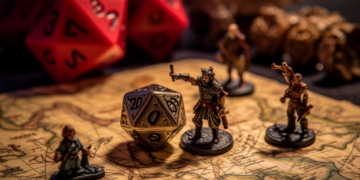
In the enthralling realm of Dungeons & Dragons, the Crown of Madness 5e spell is a fascinating and mysterious charm that allows players to control the actions of another creature. Think of it as a puppeteer’s string, carefully maneuvering the movements of the marionette. This spell has the potential to turn the tide of a battle in your favor, but like any great power, it comes with its own set of limitations. The question is, are you ready to wield this power?
Delving into the Mystical Realm of the Crown of Madness 5e
The Crown of Madness is a second-level enchantment spell that requires one action to cast and lasts up to one minute. It’s crucial to note that casting this spell doesn’t guarantee control over the creature for the entire duration. The creature, trapped within the invisible strings of your command, gets a chance to make a wisdom saving throw at the end of each of its turns. Will it break free, or will it remain ensnared in the clutches of your control?
The Enthralling Charm of the Crown of Madness 5e
As you cast the spell, an illusionary crown of jagged iron materializes on the target’s head, their eyes reflecting the glint of madness. It’s like a captivating dance of fire and ice, the cold iron crown contrasting sharply with the fiery madness flickering in the creature’s eyes. This dramatic visual effect is as much a part of the spell’s allure as its mind-bending control.
The Unseen Threads of Control
Have you ever wondered how it feels to pull the strings of someone else’s actions? The Crown of Madness spell lets you experience just that. But remember, it’s not as simple as casting the spell and sitting back to enjoy the show. The caster must be vigilant and actively direct the controlled creature.
The spell’s effectiveness greatly depends on the caster’s ability to maintain constant control and keep the creature within sight. If the creature moves out of sight or the caster is distracted, control can be lost. Can you imagine the chaos that could ensue?
The Puppeteer’s Strings: Maintaining Control Over the Creature
The Crown of Madness spell requires a great deal of concentration. Like a puppeteer carefully maneuvering a marionette, the caster must use their action on each of their turns to maintain control over the creature. If the caster is attacked or distracted, they must make a concentration check to keep the spell active. The suspense of potentially losing control adds an unpredictable twist to every combat encounter.
Consider the strategic implications of this. Do you focus on maintaining control over your puppet, or do you risk losing control to cast another spell or attack?
From Jester to King: Changing the Tide of Battle
The Crown of Madness is a game changer. Think about it. What if you could turn the strongest enemy into your ally? The tide of battle can shift dramatically, breathing a new life into a dire situation. But, it’s not just about choosing the right target, it’s about timing and positioning too.
Imagine controlling a troll to attack its allies in the middle of a chaotic battlefield. Or, what if you manipulated a rogue to disarm traps for you? The possibilities are endless and only limited by your creativity and tactical acumen.
Breaking Free from the Iron Crown: Countering the Spell
But, what happens when the tables are turned? How can you shake off the iron grip of the Crown of Madness? It’s not easy, but there are ways. The spell’s control is not absolute and can be resisted.
One of the primary ways to resist the Crown of Madness is by succeeding on a wisdom saving throw at the end of each of the creature’s turns. A high wisdom score or bonuses to saving throws can significantly increase the odds of breaking free from the spell’s control. Isn’t it exhilarating to think that every turn could potentially end your puppeteer’s control?
Another way to end the spell is for the caster to lose concentration. This can happen if the caster takes damage, fails a saving throw, or casts another concentration spell. Remember, the puppeteer can also be the puppet, controlled by the forces of the battlefield.
Finally, moving the target out of the caster’s sight is a surefire way to end the spell. But this requires careful planning and coordination, adding another layer of strategic depth to the encounter. After all, isn’t outsmarting your opponent the ultimate victory?
A Rollicking Dance with Madness: Noteworthy Encounters
Can you recall a time when the tide of a battle was abruptly shifted, or when an encounter took an unexpected and chaotic turn, all thanks to the Crown of Madness spell? The sheer unpredictability of this spell has led to countless legendary encounters that are still talked about in hushed whispers around the gaming table.
Imagine a nefarious Mind Flayer, its tentacles reaching out menacingly, suddenly halted in its tracks as a jagged iron crown appears on its head, its eyes reflecting a terrifying madness. Now, instead of attacking your party, it turns its psychic blasts on its own minions. Or picture a formidable Orc Warchief, in the heat of battle, suddenly swaying under the influence of the Crown of Madness spell, causing havoc in its own ranks.
The beauty of this spell is in its capacity to create memorable moments of triumph, chaos, and sometimes, even humor. But remember, the stories spun around this spell are not just about its successful uses. They are also about the dramatic moments when the spell fails, when the creature breaks free from the crown’s control, leaving the caster and their companions in a lurch.
The Power within Grasp: Best Classes for the Spell
The Crown of Madness spell is not for the faint-hearted. It requires a certain bravado, a willingness to take risks, and a knack for strategic thinking. And while this spell is a part of the spell list for Warlocks, Sorcerers, and Wizards, they are not the only ones who can tap into its mesmerizing power.
Warlocks, with their inherent connection to the mystical, can use this spell to great effect, manipulating their enemies to sow discord. Sorcerers, born with the raw power of magic coursing through their veins, can tap into the unpredictable nature of the spell, turning the tide of battle in an instant. Wizards, the scholars of the magic world, can use their deep understanding of arcane forces to control the spell’s effects with precision.
But what about the other classes? Are they forever barred from wielding this powerful spell? Not necessarily. Let’s take a look.
Other Classes and the Crown of Madness
- Paladin: A Paladin who chooses the Oath of Treachery (a Unearthed Arcana option) can use the Crown of Madness spell as a channel divinity option.
- Bard: Bards can gain access to this spell through their Magical Secrets feature, allowing them to choose spells from any class’s spell list.
- Artificer: Artificers, though not inherently capable of casting the Crown of Madness, can potentially use it through a magic item that has the spell, like a Wand of Fear.
However, remember that using the Crown of Madness spell effectively requires more than just having it in your spell list. It requires a deep understanding of its mechanics, its potential impact on the battlefield, and the best way to maintain control over the spell. So, are you ready to wield this power?
The Crown’s Lament: Limitations and Disadvantages of the Spell
Just like the crown of a king bears the weight of the kingdom, so does the Crown of Madness bear its own set of limitations. One of the most significant is the requirement of concentration. As you weave the spell’s enchantment, your focus is divided, leaving you vulnerable to distractions and attacks that could break your concentration and end the spell abruptly. Does this not add a thrilling element of risk to the game?
Further, the target gets to make a wisdom saving throw at the end of each of its turns, potentially breaking free from the spell’s control. The spell’s effectiveness is also limited by the target’s ability to see and hear the caster. If the target cannot see or hear the caster, the spell fails. Can you imagine the frustration of a puppeteer whose strings have been snipped?
Final Verdict: Is the Crown of Madness Worth It?
Now comes the moment of reckoning. Is the Crown of Madness spell worth the risk? The answer is not as straightforward as one might think. It’s like a two-edged sword, its effectiveness swinging wildly based on the circumstances of battle and the creatures involved.
However, to give a more tangible understanding, let’s compare the Crown of Madness to similar control spells.
| Spell | Benefits | Drawbacks |
|---|---|---|
| Crown of Madness | Control over target’s actions, potential to turn tide of battle | Requires concentration, target gets regular saving throws, target must see and hear caster |
| Charm Person | Make a humanoid friendly, can influence their actions indirectly | Target knows it was charmed after the spell ends |
| Dominate Person | Full control over target, can use target’s abilities | Requires concentration, target gets regular saving throws |
| Hold Person | Paralyze a humanoid, leaving it vulnerable to attacks | Requires concentration, target gets regular saving throws |
Unveiling Other Control Spells
While the Crown of Madness holds its charm, the realm of control spells in D&D 5e is vast and teeming with countless possibilities. From the more subtle Charm Person to the powerful Dominate Person, each spell offers its unique blend of control and chaos.
So, why not step out of the shadow of the Crown of Madness and embrace the unpredictability of these other spells? After all, isn’t the thrill of the unknown, the unexpected twists and turns, what truly makes the game of D&D so captivating?
So, whether you choose to wield the Crown of Madness or not, remember, every spell in your arsenal is a tool for epic adventures and unforgettable stories. Embrace the magic, embrace the chaos, and most importantly, have fun!






